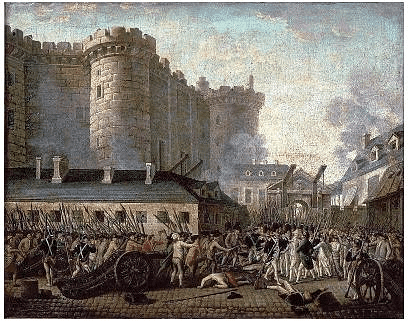Key Concepts: The Rise of Nationalism in Europe | Social Studies (SST) Class 10 PDF Download
Definitions
Frederic Sorrieu: He was a French artist famous for prints prepared in 1848 that visualized the dream of a world consisting of Democratic and Social Republics. Frederic Sorrieu - Universal Democratic and Social Republic
Frederic Sorrieu - Universal Democratic and Social Republic
Nineteenth-Century: Associated with the rise of nationalism and nation-states.
Nationalism: A feeling of oneness with the society or the state, love and devotion for the motherland and belief in the political identity of one's country are the basic attributes of nationalism.
Nation State: A state that establishes itself as a separate political and geographical entity and functions as a complete and sovereign territorial unit. This concept emerged in 19th century Europe as a result of the growth of nationalism.
Modern State: A state in which sovereignty is exercised by a centralized power over a specific territory and population.
Absolutist Government: A system of government wherein limitless powers is vested in a single person or body. It is a monarchical form of government in which the ruler is the absolute authority and is not answerable to anybody.
French Revolution (1789)
- It marks the beginning of nationalism.
- France was under the absolute monarchy in 1789.
- The Revolution transferred sovereignty from the monarch to the French people.
- Ideas of La Patrie (the fatherhood) and Le citoyen (the citizen) adopted.
- French Flag, the tricolour, adopted replacing the royal standard.
- Estates-General elected by citizens and renamed the National Assembly.
- A centralized political system was established.
- Internal custom dues abolished.
- Uniform weights and measures adopted.
- French became the language of the nation.
- French armies moved into Holland, Belgium, Switzerland, and Italy in the 1790's with a promise of liberating the people from their despotic rulers.

Napoleon (1769-1821)
- Ruled France from 1799 to 1815.
- Assumed absolute powers in 1799 by becoming the First Consul.
- Civil Code/Napoleonic Code (1804)
- Established equality before the law.
- Abolished all privileges based on birth.
- Granted the right to property to French citizens.
- Simplified administrative divisions.
- Abolished feudal system and freed peasants from serfdom.
- Removed restrictions on guilds in towns.
- Improved transport and communication.
- Militarily, Napoleon proved to be an oppressor for the people of the conquered territories. Taxation and censorship were imposed and military services were made mandatory.
Europe in the mid-18th Century
There were no Nation States as the Europeans never saw themselves as sharing a common identity or culture.
Example: The Habsburg Empire of Austria–Hungary comprised French, Italian and German-speaking people.
Europe was broadly divided into two classes during this period namely:
1. Aristocracy: The landowning class. Numerically small, but dominated Europe, both socially and politically. Spoke French which was considered the language of the high society. Families were connected through marriage.
2. Peasantry: Tenants and small landowners who worked as serfs. Cultivated the lands of the aristocratic lords.
The growth of trade and industrial production facilitated the growth of towns and the rise of a commercial class of traders. Consequently, the new conscious, educated, liberal middle class emerged and popularized nationalism and stood for the abolition of aristocracy.
Liberal Nationalism
It Means Individual freedom, Equality before the law, Government by consent, Freedom of markets, Abolition of state-imposed restrictions on the movement of goods and capital.
Liberalism became the main concern in Europe after the French Revolution because:
(a) Universal Adult Suffrage was not granted to the people by the Napoleonic Code.
(b) Men without property and women were denied the right to vote.
(c) Women were made subject to the authority of men.
(d) Markets were not free as the 39 confederacies of France had their own laws which posed problems for the free movement of goods.
(e) There were no standard weights and measures and no fixed rates of customs duties, which greatly affected the trade.
Conservatism
Stands for the preservation of the traditional institutions of state and society such as the monarchy, the church, social hierarchies and family along with the modern changes introduced by Napoleon. Conservatism as a political ideology arose after the defeat of Napoleon in 1815 at the Battle of Waterloo.
The conservative regimes:
- Were autocratic
- Were intolerant to criticism and dissent
- Adopted the censorship of press for curbing the liberal ideals
- Discouraged any questions that challenged their legitimacy
Congress of Vienna (1815)
For drawing a new settlement for Europe and restoring the monarchies that were overthrown by Napoleon for creation of a new conservative order.
The salient features of the Treaty were as follows:
- The Bourbon dynasty was restored to power in France.
- France was disposed of its conquered territories.
- Kingdom of the Netherlands, which included Belgium, was set up in the North and Genoa was set up in the South for preventing French expansion in future.
- Prussia was given new territories, including a portion of Saxony.
- Austria got control over Northern Italy.
- Russia got Poland. Napoleon's confederation of 39 states was not changed.
The Revolutionaries
The Revolutionaries uphold the idea of liberalism and were against the conservative regimes of the 19th Century.
Many secret societies were formed whose main aims were:
- Training the revolutionaries and spreading their ideas throughout Europe.
- Opposing monarchical governments established after the Vienna Congress of 1815.
- Fighting for liberty and freedom from autocratic rule.
- Emphasizing the idea of creation of nation-states.
Romanticism as part of cultural movement
- Romantic poets and artists glorified emotions and mystic feelings in place of reason and science.
- They helped to develop a sense of shared collective heritage.
- They encouraged the spirit of the nation through folk songs, poetry and dances.
- Greek War of Independence was the culmination of nationalistic feelings and Romantic imagination. Poets and artists mobilized public opinion in favour of the Greeks living under the Ottoman Empire.
- Romantic nationalism in Poland took place even after Poland was partitioned by the Great Powers Russia, Prussia and Austria. Nationalistic feelings in Poland were kept alive through music and language.
The Revolution of the Liberals (1848)
- In 1848 another revolution occurred in France. A Republic was established and universal male suffrage was granted in France.
- In other parts of Europe, such as, Germany, Italy, Poland and Austro-Hungarian Empire, the liberal middle-class demanded constitutionalism with national unification.
- They demanded creation of Nation States with freedom of press and freedom of association.
The making of Germany and Italy
- Unification of Germany was achieved by a national movement under the leadership of Otto Von Bismarck, Chief Minister of Prussia.
- King Victor Emmanuel II unified Italy after defeating the Austrian forces in 1859.
Visualizing the Nation
- Nations were portrayed as female figures by artists in the 18th and 19th centuries.
- Ideas of liberty, justice and republic were represented by the artists as female allegory.
- Marianne a popular Christian name was given to the imaginary female figure which represented France as a nation. Statues of Marianne were placed in public squares. She is shown wearing a red cap, symbolizing liberty and a tri-colored cockade, symbolizing freedom.
- Germania was the imaginary female figure chosen as an allegory for the German nation. Germania wore a crown of oak leaves. Oak stood for heroism in Germany.
|
63 videos|445 docs|87 tests
|
FAQs on Key Concepts: The Rise of Nationalism in Europe - Social Studies (SST) Class 10
| 1. What were the main causes of the French Revolution in 1789? |  |
| 2. How did Napoleon rise to power and what were the key events of his reign? |  |
| 3. What were the main goals and outcomes of the Congress of Vienna in 1815? |  |
| 4. How did liberal nationalism and conservatism influence Europe in the mid-18th century? |  |
| 5. What were the main characteristics and impact of Romanticism as a cultural movement in Europe? |  |

|
Explore Courses for Class 10 exam
|

|



















